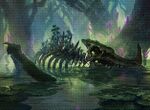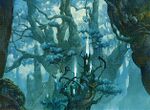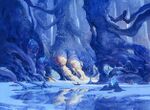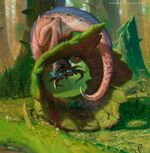Zagoth
| Zagoth | |
|---|---|
| Information | |
| Plane | Ikoria |
| Colors |
|
| Type | Swamp Forest Island |
| Scryfall Statistics | |
|
23 artworks | |
Zagoth is one of the five triomes that make up the continent of Ikoria, a plane known for its wild, monster-dominated ecosystem. This particular region is defined by a dense combination of rainforest, swamp, and wetland biomes. Zagoth is primarily aligned with green mana, though it also has significant associations with blue and black mana.[1] The region is home to a massive range of flora and fauna, most of which have evolved or mutated into monstrous forms, and many of which are of interest to monster hunters, researchers, and opportunistic traders.
Description
Zagoth encompasses a sprawling and vibrant wilderness filled with thick jungles, saturated wetlands, and fungal growths that form towering, mushroom-like trees. This humid and biologically rich environment is shaped by an almost continuous cycle of growth and decay, where massive plant life and enormous animal-like monsters interact in complex and often violent ways. Much of the terrain is submerged or waterlogged, with wide ponds and interconnected marshes forming the foundation for dense groves of exotic vegetation.

One of Zagoth's most notable natural features is its network of oversized lily plants, which dominate the region's waterways. These aquatic plants can grow to astonishing sizes—some reaching more than thirty feet across—and are strong enough to support the weight of several large creatures at once. For travelers and locals alike, these floating lilies offer one of the safest and most direct ways to navigate through otherwise impassable wetland terrain. Many creatures, both monster and mundane, use these lilies as resting platforms or hunting grounds.

The region is also known for its groves of fanspore trees, which grow in large clusters and attract vast populations of brightly colored and bioluminescent insects. These insects often coat the plants and air with shifting glows of color and movement. Zagoth supports a wide variety of massive herbivorous beast monsters that travel in herds and feed on the diverse plant life. These herds often migrate based on the growth cycle of the vegetation they consume, with some species following others to graze on specific plant components. For example, one group may consume tougher leaves and outer bark, while the next group feeds on the exposed fruits and softer growths left behind.

The region's natural resources, especially its monster populations, have made it a frequent destination for monster hunters and trappers. The horns, tusks, hides, and even meat of Zagoth's beasts are all valuable commodities. Many skilled hunters set up temporary camps along the edges of wetlands or atop stable platforms formed from clustered lily pads. While some come for sport, most are motivated by trade and survival, seeking items that can be sold in safer regions of Ikoria. Despite its apparent natural abundance, Zagoth remains a dangerous and unpredictable landscape, and only the most experienced or well-prepared travelers can hope to survive long within its depths.
From the nutrient-rich soil and swampy terrain of Zagoth, nearly every form of life imaginable can emerge—whether plant, animal, or mineral. Crystalline formations are sometimes found embedded in tree roots or marsh beds, alongside rare botanical specimens that thrive only in this high-humidity environment.[2]
Dominant clade

Among the monster types present throughout Zagoth, the beast clade is the most dominant by far. These monsters take on a wide range of forms and sizes, but most bear physical similarities to familiar herbivorous creatures from other planes, such as antelopes, elk, boars, horses, rhinos, or camels. However, their scale and behavior are heavily influenced by the unique evolutionary pressures of Ikoria. While many beasts are herbivores and travel in peaceful herds, they can become highly aggressive if startled or if they perceive a threat to their territory.
Beast monsters in Zagoth often have thick, shaggy hides and protective skin capable of deflecting physical damage. Many sport horns, tusks, antlers, or bony plates as natural armor or display. Their legs are generally short and powerful, ending in hooves, claws, or stumpy feet designed to move through swampy and uneven terrain. Some are slow-moving and immense, while others are leaner and faster, resembling fleet-footed antelopes or wild horses. Due to their reliance on plant life, many beasts respond positively to offerings of food such as fruit, leaves, or sap. Skilled beastbonders can sometimes pacify or redirect beasts using foraged food sources or scent-based lures.
The apex monster of Zagoth is the powerful and ancient Brokkos, a beast of titanic proportions that has become both a figure of fear and awe in the region. Brokkos embodies many of the traits associated with Zagoth itself: resilience, size, territorial dominance, and deep connection to the natural world. The presence of Brokkos and other legendary monsters ensures that Zagoth remains one of the most dangerous and biologically diverse areas of all Ikoria.
In-game references
- Represented in:
- Associated cards:
- Referred to:
References
- ↑ Chris Mooney (April 02, 2020). "Planeswalker's Guide to Ikoria". magicthegathering.com. Wizards of the Coast.
- ↑ Flavor text of Zagoth Crystal
